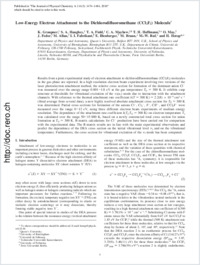Low-energy electron attachment to the dichlorodifluoromethane (CCl₂F₂) molecule
- Graupner, K. Department of Physics and Astronomy, Queen’s University, Belfast, U.K.
- Haughey, S. A. Department of Physics and Astronomy, Queen’s University, Belfast, U.K.
- Field, T. A. Department of Physics and Astronomy, Queen’s University, Belfast, U.K.
- Mayhew, C. A. Department of Physics and Astronomy, Queen’s University, Belfast, U.K. - School of Physics and Astronomy, University of Birmingham, U.K
- Hoffmann, T. H. Département de Chimie, Université de Fribourg, Switzerland - Fachbereich Physik, Technische Universität Kaiserslautern, Germany
- May, Olivier Département de Chimie, Université de Fribourg, Switzerland
- Fedor, Juraj Département de Chimie, Université de Fribourg, Switzerland
- Allan, Michael Département de Chimie, Université de Fribourg, Switzerland
- Fabrikant, Ilya I. Department of Physics and Astronomy, University of Nebraska, Lincoln, USA
- Illenberger, E. Physikalische und Theoretische Chemie, Freie Universität Berlin, Germany
- Braun, M. Fachbereich Physik, Technische Universität Kaiserslautern, Germany
- Ruf, M.-W. Fachbereich Physik, Technische Universität Kaiserslautern, Germany
- Hotop, Hartmut Fachbereich Physik, Technische Universität Kaiserslautern, Germany
-
29.12.2009
Published in:
- The Journal of Physical Chemistry A. - 2010, vol. 114, no. 3, p. 1474–1484
English
Results from a joint experimental study of electron attachment to dichlorodifluoromethane (CCl₂F₂) molecules in the gas phase are reported. In a high resolution electron beam experiment involving two versions of the laser photoelectron attachment method, the relative cross section for formation of the dominant anion Cl⁻ was measured over the energy range 0.001−1.8 eV at the gas temperature TG = 300 K. It exhibits cusp structure at thresholds for vibrational excitation of the ν₃(a₁) mode due to interaction with the attachment channels. With reference to the thermal attachment rate coefficient k(T = 300 K) = 2.2(8) × 10⁻⁹ cm³ s⁻¹ (fitted average from several data), a new highly resolved absolute attachment cross section for TG = 300 K was determined. Partial cross sections for formation of the anions Cl⁻, Cl₂⁻, F⁻, ClF⁻, and CCl₂F⁻ were measured over the range 0−12 eV, using three different electron beam experiments of medium energy resolution. The dependence of the attachment rate coefficient k(Te;TG = 300 K) on electron temperature Te was calculated over the range 50−15000 K, based on a newly constructed total cross section for anion formation at TG = 300 K. R-matrix calculations for Cl⁻ production have been carried out for comparison with the experimental data. The R-matrix results are in line with the main experimental observations and predict the dependence of the DEA cross section on the initial vibrational level ν₃ and on the vibrational temperature. Furthermore, the cross section for vibrational excitation of the ν₃ mode has been computed.
- Faculty
- Faculté des sciences et de médecine
- Department
- Département de Chimie
- Language
-
- English
- Classification
- Chemistry
- License
-
License undefined
- Identifiers
-
- RERO DOC 17176
- DOI 10.1021/jp9081992
- Persistent URL
- https://folia.unifr.ch/unifr/documents/301458
Statistics
Document views: 190
File downloads:
- pdf: 218
